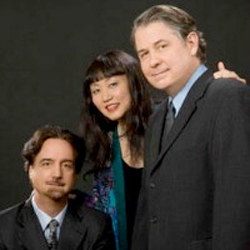by Daniel Hathaway

Though involved in other, primary activities, pianist Wu Han, violinist Philip Setzer and cellist David Finckel perform together so frequently as a trio that they enjoy the kind of uncanny sense of communication common to professional tennis doubles partners. That allows them — along with their superb musicality and impressive technique — to toss off thornily difficult music like Beethoven’s Trio in G, op. 1, no. 2 not only with wit and grace, but also with a remarkable depth of understanding and attention to detail.
Written when Beethoven wanted to show off his prowess as a 24-year-old piano virtuoso, the G Major Trio asks a lot of its keyboard player and, ensemble-wise, of all three musicians. Han, Setzer and Finckel brought out the composer’s playful inventiveness in the first Allegro, created an exquisitely soft ending to the Largo movement and merrily punched up the offbeat accents and articulations in the Scherzo. The finale bears more than a little resemblance to the famous William Tell Overture theme, and the trio had great fun with it. At one point, when Han and Setzer seemed to be keeping that exuberant motive all to themselves, Finckel pretended to be waiting petulantly for his own turn, an opportunity he finally seized with gusto.
The evening went from bright cheerfulness to deep gloom almost from the eerie beginning of Shostakovich’s second piano trio, passages of which suggested moments from a famous Bernard Hermann film score. The distraction of a robust, romping Allegro gave way to a Largo in the form of a passacaglia portentous with piano chords, some consonant, some dissonant. The finale moved inexorably into regions of crazed despair with a persistent, made-up Klezmer-like theme and a strange, inconclusive ending.
Shostakovich had a lot on his mind here: the untimely death of a friend, the second World War, memories of the siege of Leningrad, the persecution of the Jews. Han, Setzer and Finckel gave the audience an almost unbearably intense musical experience in just twenty-seven minutes, as committed now to Shostakovich’s emotional mood swings as they had been to Beethoven’s earlier ebullience.
Rarely has an intermission felt so necessary in the arc of a performance. Afterward, Mendelssohn’s second trio, op. 66, restored a psychological balance. Tuneful and dramatic but far from tragic, the c-minor trio brought us back from the horrors of war into the relative safety of a music room in Hamburg. Like Beethoven, Mendelssohn also wrote fleet-fingered music for himself, and Wu Han played those lines in the opening Allegro with shapely skill. The song-like Andante was charming, the perpetual-motion Scherzo as light as a soufflé. Mendelssohn marked the finale “appassionata,” a direction the player took to heart, but yet found time to linger for an expressive nanosecond on the first notes of its fugue subject.
A partial standing ovation after the Shostakovich turned into unanimity after the Mendelssohn. The Trio returned to play a spirited encore — the Dumka No. 4 from Dvořák’s d-minor Trio. Wu Han prefaced the performance with the note that not only had she played the piece the week before in the composer’s house in Prague, but she also went to dinner with Antonin Dvořák III. Hands across the decades!
Published on ClevelandClassical.com September 30, 2014.
Click here for a printable copy of this article.


